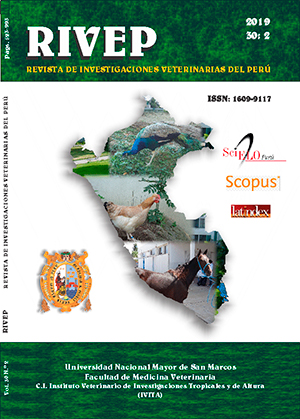Detection of antibodies and risk factors associated with Toxoplasma gondii in wild animals in a zoo
DOI:
https://doi.org/10.15381/rivep.v30i2.16069Keywords:
Toxoplasma gondii; wild animals; Rattus sp; Felis silvestris f. catus; antibodiesAbstract
The aim of this study was to determine the presence of antibodies against Toxoplasma. gondii in wild animals of the orders Carnivora, Primates, Perissodactyla, Cetartiodactyla and Rodentia in the zoo of the Patronato del Parque de las Leyendas, Lima, Peru, as well as to identify the risk factors associated to toxoplasmosis, establishing the role in the transmission of the parasite of domestic felines (Felis silvestris f. catus) and rodents of the genus Rattus running free in the zoo. Blood samples were taken from 332 animals (Carnivora: 75, Primates: 71, Perissodactyla: 32, Cetartiodactyla: 134, Rodentia: 20); as well as in 41 domestic felines and 124 rodents of the genus Rattus. In addition, samples of brain, heart, liver and diaphragm from the rodents for histopathological and immunohistochemical analysis. Serum samples were analysed by indirect hemagglutination (1:64 - 1: 2048), considering as positive titres greater ≥1/64. Antibodies (IgG, IgM) were determined by 2-Mercaptoethanol to determine acute and chronic infections. In the evaluation of the risk factors, the variables order, sex, time in the institution (<5, 6-10, >10 years) and type of enclosure (open and closed) were analysed by multiple logistic regression analysis adjusted to Stepwise. The frequency of anti-T. gondii antibodies in wild animals in captivity was 77.1 ± 4.4%, with serological main reactivity of IgG (73.4%, chronic cases) and strong serological response (1/2048) in 53.9% of the animals. The risk factors associated with the transmission of T. gondii were the order, animals with more than 10 years in the zoo (OR: 4.18) and exhibited in open area (3.99) (p<0.05). Rodents and cats that roam in the zoo had a low (11.3 ± 6.0) and moderate (58.5 ± 15.2) frequency of anti-T. gondii antibodies respectively. Tissue cysts were detected in cardiac and skeletal muscles (diaphragm) in rodents (4%, 5/124), but the presence of T. gondii could not be demonstrated by immunohistochemistry.
Downloads
Downloads
Published
Issue
Section
License
Copyright (c) 2019 Rosa Pinedo V., Amanda Chávez V., Karina Muñoz D., Omar Gonzáles-Viera, Eva Casas A., Deisy Abad A., Eglinton Villacaqui A.

This work is licensed under a Creative Commons Attribution-NonCommercial-ShareAlike 4.0 International License.
AUTHORS RETAIN THEIR RIGHTS:
a. Authors retain their trade mark rights and patent, and also on any process or procedure described in the article.
b. Authors retain their right to share, copy, distribute, perform and publicly communicate their article (eg, to place their article in an institutional repository or publish it in a book), with an acknowledgment of its initial publication in the Revista de Investigaciones Veterinarias del Perú (RIVEP).
c. Authors retain theirs right to make a subsequent publication of their work, to use the article or any part thereof (eg a compilation of his papers, lecture notes, thesis, or a book), always indicating the source of publication (the originator of the work, journal, volume, number and date).










